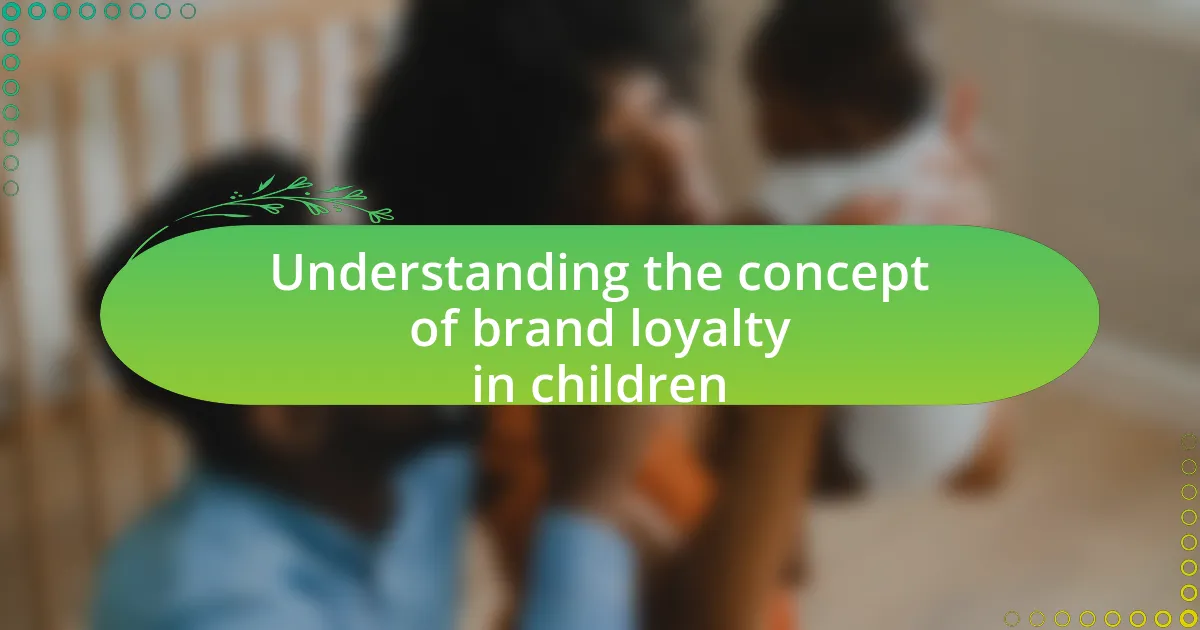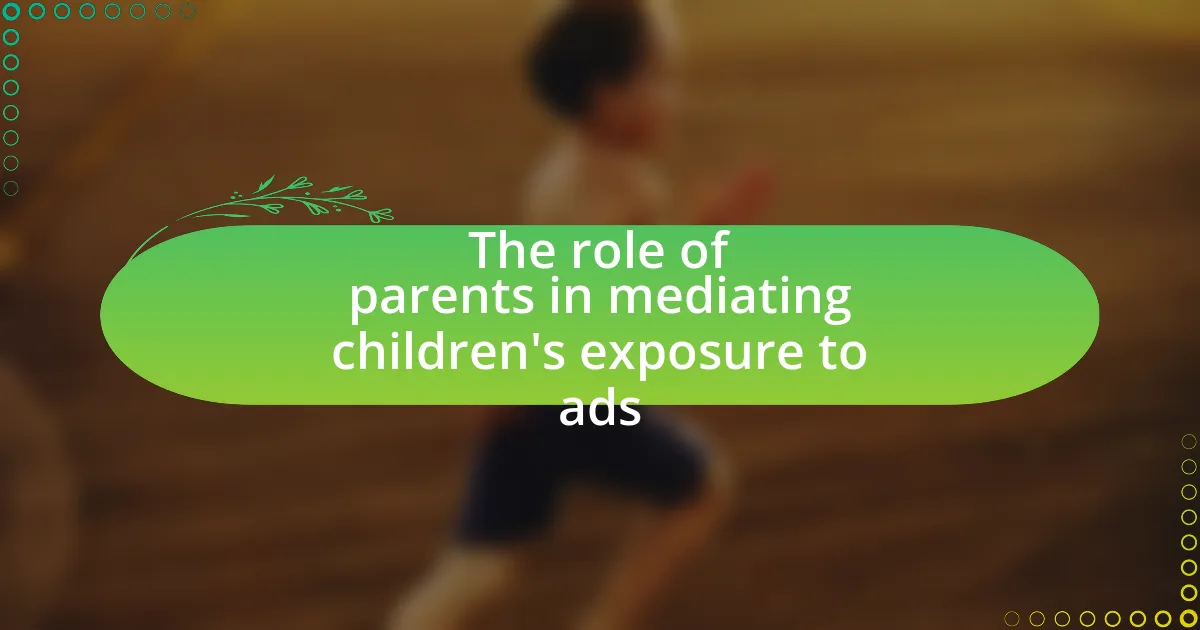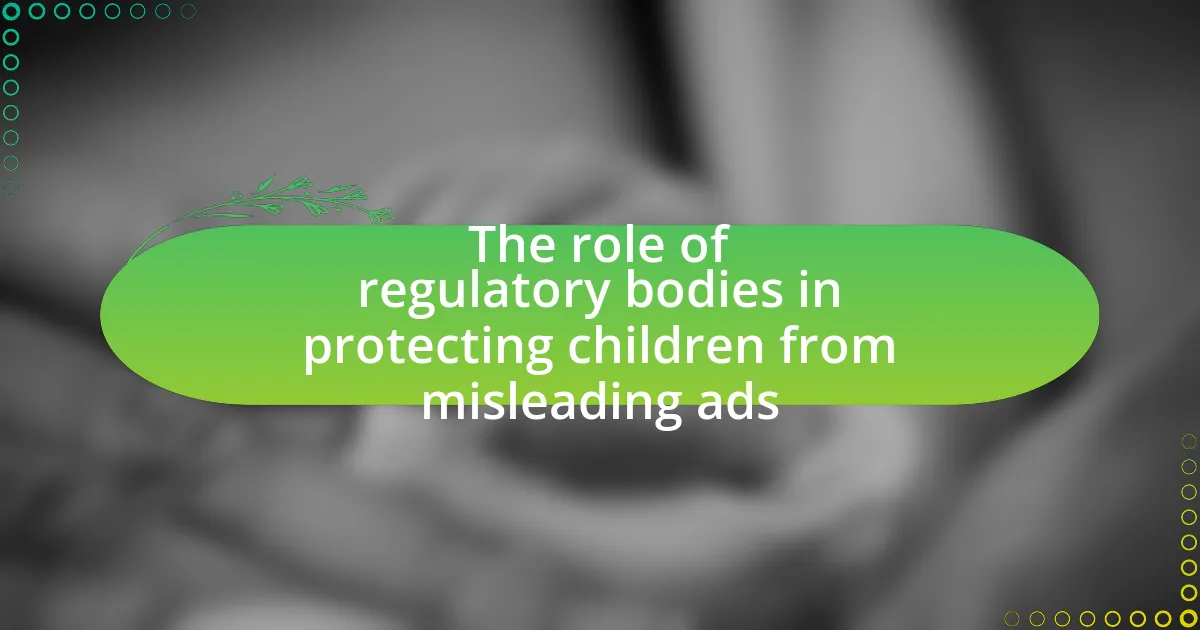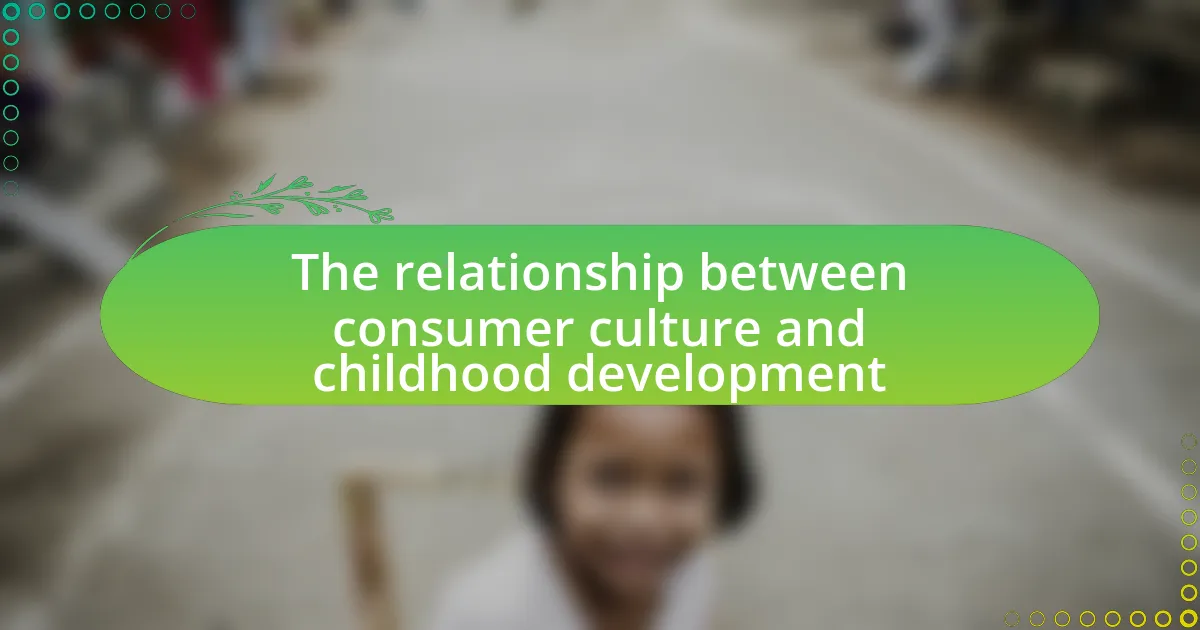The article focuses on successful media literacy programs for children, highlighting initiatives such as “Media Smarts” in Canada and the “Digital Citizenship Curriculum” by Common Sense Education. It defines media literacy as the ability to access, analyze, evaluate, and create media, emphasizing critical thinking skills essential for discerning credible information. The article discusses key skills taught in these programs, the benefits of media literacy for children’s understanding of media, and the challenges they face in today’s digital landscape. Additionally, it explores methodologies used in these programs, the role of educators, and strategies for overcoming implementation barriers, ultimately underscoring the importance of integrating media literacy into educational curricula.

What are successful media literacy programs for children?
Successful media literacy programs for children include the “Media Smarts” initiative in Canada, which provides resources and training for educators to teach critical thinking about media. This program has been effective in enhancing children’s ability to analyze and evaluate media messages, as evidenced by a study showing improved media literacy skills among participants. Another example is the “Digital Citizenship Curriculum” developed by Common Sense Education, which focuses on responsible online behavior and critical media consumption. Research indicates that students who engage with this curriculum demonstrate a greater understanding of digital media’s impact on their lives. These programs exemplify effective strategies for fostering media literacy in children.
How do these programs define media literacy?
These programs define media literacy as the ability to access, analyze, evaluate, and create media in various forms. This definition emphasizes critical thinking skills and the understanding of media’s role in society, enabling children to discern credible information from misinformation. For instance, the National Association for Media Literacy Education outlines that media literacy involves not only the consumption of media but also the production and critical evaluation of media content, which is essential for informed citizenship in a digital age.
What key skills are taught in media literacy programs?
Media literacy programs teach critical thinking, analysis of media messages, and evaluation of sources. These skills enable individuals to discern the credibility of information, understand the influence of media on perceptions, and engage with content thoughtfully. Research indicates that students who participate in media literacy programs demonstrate improved abilities to assess the reliability of news sources and recognize bias, as evidenced by studies conducted by the Center for Media Literacy, which highlight enhanced analytical skills in participants.
How do these skills benefit children’s understanding of media?
Media literacy skills enhance children’s understanding of media by enabling them to critically analyze content, discern credible sources, and recognize bias. These skills empower children to navigate the complex media landscape, fostering informed decision-making and reducing susceptibility to misinformation. Research indicates that children who participate in media literacy programs demonstrate improved critical thinking abilities and a greater understanding of media’s influence on society, as evidenced by studies conducted by the Center for Media Literacy, which show that students exposed to media literacy education are more adept at evaluating media messages and understanding their implications.
Why is media literacy important for children today?
Media literacy is crucial for children today because it equips them with the skills to critically analyze and evaluate the vast amount of information they encounter daily. In an age dominated by digital media, children are exposed to various messages that can influence their beliefs, behaviors, and understanding of the world. Research indicates that media literacy education can significantly enhance children’s ability to discern credible sources from misinformation, thereby fostering informed decision-making. For instance, a study by the Center for Media Literacy found that students who participated in media literacy programs demonstrated improved critical thinking skills and a greater understanding of media’s role in society. This underscores the importance of integrating media literacy into educational curricula to prepare children for the complexities of the modern information landscape.
What challenges do children face in the media landscape?
Children face several challenges in the media landscape, including exposure to misinformation, cyberbullying, and the impact of screen time on mental health. Misinformation can lead to confusion and misinterpretation of facts, as studies show that children often struggle to differentiate between credible sources and unreliable content. Cyberbullying affects a significant number of children, with reports indicating that approximately 15% of students in grades 9-12 have experienced online harassment. Additionally, excessive screen time has been linked to increased anxiety and depression among children, with research from the American Academy of Pediatrics highlighting the need for balanced media consumption. These challenges underscore the importance of media literacy programs that equip children with the skills to navigate the complex media environment effectively.
How can media literacy programs address these challenges?
Media literacy programs can address challenges by equipping children with critical thinking skills necessary to analyze and evaluate media content. These programs teach children to discern credible information from misinformation, fostering an understanding of media influence on perceptions and behaviors. For instance, studies show that students who participate in media literacy initiatives demonstrate improved ability to identify biased or misleading information, as evidenced by research from the Center for Media Literacy, which highlights a 30% increase in critical analysis skills among participants. By integrating practical exercises and discussions about real-world media examples, these programs empower children to navigate the complex media landscape effectively.
What are some examples of successful media literacy programs?
Some examples of successful media literacy programs include the “Media Smarts” initiative in Canada, which provides resources and training for educators to teach students critical thinking skills regarding media content. Another example is the “Digital Citizenship Curriculum” developed by Common Sense Education, which equips students with the knowledge to navigate digital media responsibly. Additionally, the “News Literacy Project” in the United States focuses on helping students discern credible news sources, enhancing their ability to evaluate information critically. These programs have demonstrated effectiveness in improving students’ media literacy skills, as evidenced by increased critical thinking and responsible media consumption among participants.
What specific outcomes have been observed in these programs?
Specific outcomes observed in successful media literacy programs for children include improved critical thinking skills, enhanced ability to analyze media messages, and increased awareness of media influence on behavior and attitudes. For instance, a study conducted by the Joan Ganz Cooney Center found that children who participated in media literacy programs demonstrated a 30% increase in their ability to critically evaluate advertisements. Additionally, programs like the “Media Smarts” initiative reported that 85% of participants felt more confident in discussing media content with peers and adults. These outcomes indicate that such programs effectively equip children with essential skills for navigating the media landscape.
How do these programs measure their success?
These programs measure their success through various metrics, including participant engagement, knowledge retention, and behavioral changes. For instance, pre- and post-program assessments are commonly utilized to evaluate knowledge gains, while surveys and interviews can gauge participant engagement and satisfaction. Additionally, tracking the application of learned skills in real-world scenarios, such as improved critical thinking when consuming media, serves as a concrete indicator of success. Research indicates that programs demonstrating a 20% increase in media literacy scores post-intervention effectively illustrate their impact on children’s understanding of media.
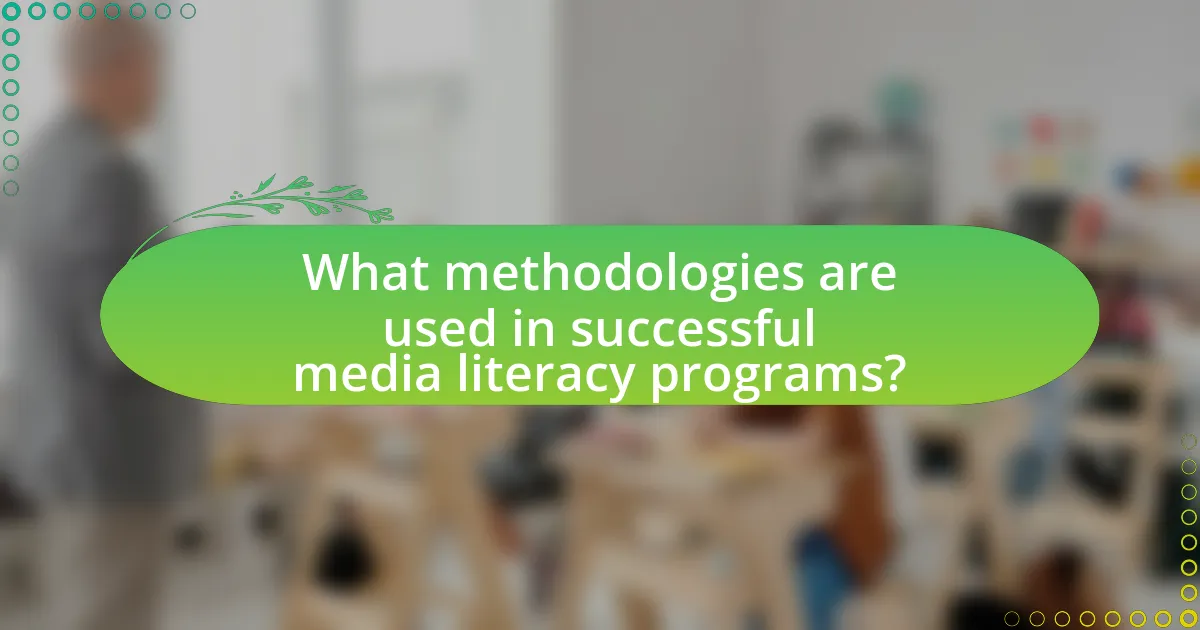
What methodologies are used in successful media literacy programs?
Successful media literacy programs utilize methodologies such as critical analysis, hands-on activities, and collaborative learning. Critical analysis encourages participants to evaluate media messages critically, fostering skills to discern bias and misinformation. Hands-on activities, such as creating media content, allow learners to apply their knowledge practically, enhancing engagement and understanding. Collaborative learning promotes discussion and peer feedback, which reinforces concepts and encourages diverse perspectives. Research indicates that programs incorporating these methodologies, like the MediaSmarts initiative in Canada, show improved media literacy skills among children, demonstrating their effectiveness in educational settings.
How do these programs engage children in learning?
These programs engage children in learning by incorporating interactive and hands-on activities that promote critical thinking and creativity. For instance, successful media literacy programs often utilize project-based learning, where children create their own media content, allowing them to apply concepts in a practical context. Research indicates that such engagement strategies enhance retention and understanding, as children are more likely to remember information when they actively participate in the learning process. Additionally, programs that include discussions and collaborative tasks foster social interaction, which further deepens comprehension and encourages diverse perspectives.
What interactive techniques are commonly employed?
Commonly employed interactive techniques in media literacy programs for children include hands-on activities, group discussions, role-playing, and digital storytelling. These techniques engage children actively, fostering critical thinking and collaboration. For instance, hands-on activities allow children to create their own media content, enhancing their understanding of media production. Group discussions facilitate the exchange of ideas and perspectives, promoting analytical skills. Role-playing enables children to explore different viewpoints and scenarios, while digital storytelling encourages creativity and personal expression. Research indicates that these interactive methods significantly improve children’s media literacy skills, as evidenced by programs like the “Media Smarts” initiative, which reported increased engagement and understanding among participants.
How do these techniques enhance retention of information?
Techniques used in media literacy programs enhance retention of information by actively engaging children in critical thinking and analysis. These programs often incorporate interactive activities, such as discussions and hands-on projects, which promote deeper cognitive processing. Research indicates that active learning strategies, like those employed in media literacy, can improve retention rates by up to 75% compared to traditional passive learning methods. For instance, a study by the National Association for Media Literacy Education found that students who participated in interactive media literacy workshops demonstrated significantly better recall of information and critical evaluation skills than those who did not engage in such activities.
What role do educators play in these programs?
Educators play a crucial role in media literacy programs for children by facilitating learning and guiding students in critical thinking about media content. They design and implement curricula that help students analyze, evaluate, and create media, fostering skills necessary for navigating the digital landscape. Research indicates that effective educators employ interactive teaching methods, such as discussions and hands-on projects, to engage students and enhance their understanding of media’s impact on society. For instance, a study by the Center for Media Literacy highlights that educators who integrate media literacy into their teaching not only improve students’ analytical skills but also empower them to become informed media consumers.
How are educators trained to deliver media literacy content?
Educators are trained to deliver media literacy content through specialized professional development programs that focus on critical thinking, digital literacy, and the evaluation of media sources. These programs often include workshops, online courses, and collaborative learning experiences that equip educators with the necessary skills to teach students how to analyze and interpret media messages effectively. Research indicates that effective training incorporates hands-on activities and real-world applications, allowing educators to practice the skills they will teach. For example, the Media Literacy Now initiative provides resources and training for educators to enhance their media literacy instruction, demonstrating the importance of structured training in fostering competent media literacy educators.
What support systems are in place for educators?
Support systems for educators include professional development programs, mentorship initiatives, and access to educational resources. Professional development programs offer training in media literacy, equipping educators with the skills necessary to teach children effectively. Mentorship initiatives connect experienced educators with newcomers, fostering a supportive environment for sharing best practices. Additionally, access to educational resources, such as curriculum guides and teaching materials, enhances educators’ ability to implement media literacy programs successfully. These systems collectively contribute to improving educational outcomes in media literacy for children.
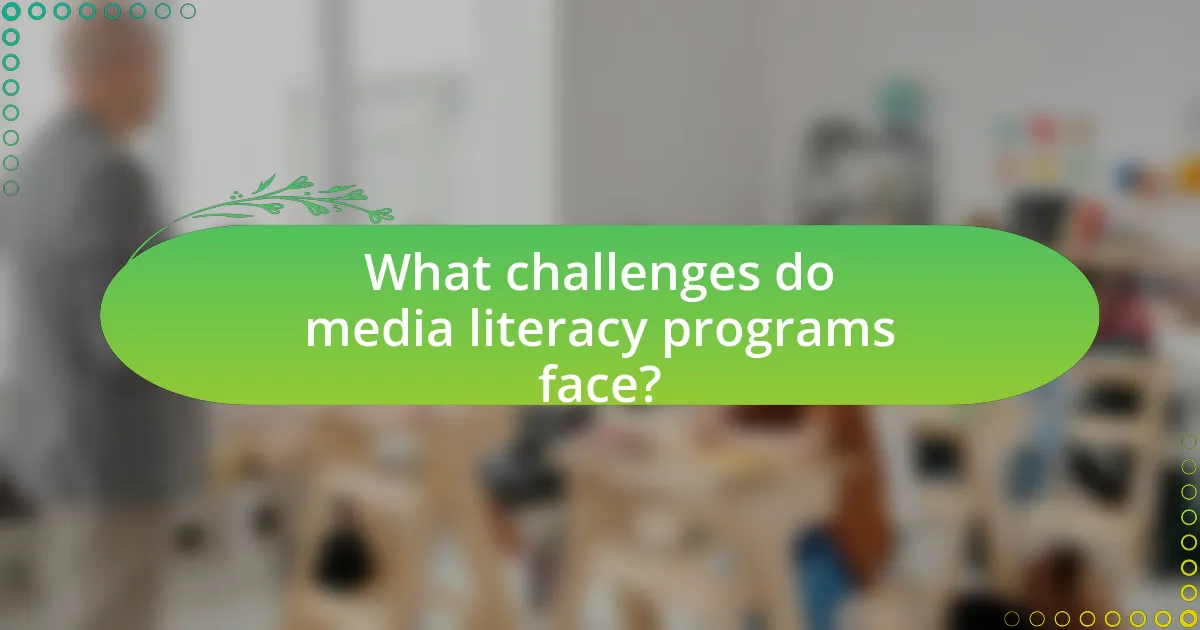
What challenges do media literacy programs face?
Media literacy programs face several challenges, including varying levels of access to technology, differing educational standards, and resistance from stakeholders. Access to technology is crucial, as students in under-resourced areas may lack the necessary devices or internet connectivity, hindering their ability to engage with media literacy content. Furthermore, educational standards for media literacy vary significantly across regions, leading to inconsistencies in program implementation and effectiveness. Resistance from parents, educators, or policymakers can also impede the adoption of media literacy initiatives, often stemming from misconceptions about the importance of media education. These challenges collectively impact the reach and success of media literacy programs aimed at children.
What barriers exist in implementing these programs?
Barriers in implementing media literacy programs for children include insufficient funding, lack of trained educators, and resistance from parents or communities. Insufficient funding limits resources for program development and delivery, as evidenced by a report from the National Association for Media Literacy Education, which highlights that many schools struggle to allocate budgets for such initiatives. The lack of trained educators hampers effective teaching, as many teachers may not feel confident in their media literacy skills, according to research by the Center for Media Literacy. Additionally, resistance from parents or communities can arise due to differing views on media consumption and education, which can hinder program acceptance and participation.
How can funding impact the success of media literacy initiatives?
Funding significantly impacts the success of media literacy initiatives by providing essential resources for program development, implementation, and sustainability. Adequate financial support allows organizations to create high-quality educational materials, hire skilled educators, and conduct outreach activities that engage children effectively. For instance, a study by the Joan Ganz Cooney Center found that programs with robust funding were able to reach a larger audience and achieve better educational outcomes, demonstrating that financial investment directly correlates with program effectiveness. Additionally, funding enables ongoing evaluation and adaptation of initiatives, ensuring they remain relevant and impactful in an evolving media landscape.
What resistance might educators or parents have towards these programs?
Educators and parents may resist media literacy programs due to concerns about curriculum overload and the effectiveness of such programs. Many educators feel that existing curricula are already packed, leaving little room for additional subjects, which can lead to skepticism about the necessity of media literacy. Parents may worry that these programs do not adequately prepare children for real-world challenges or that they may introduce controversial topics that could conflict with personal beliefs. Research indicates that 60% of teachers express concern about the integration of new programs into their already full schedules, highlighting a significant barrier to acceptance.
How can these challenges be overcome?
To overcome challenges in implementing media literacy programs for children, stakeholders must prioritize collaboration among educators, parents, and community organizations. This collaboration can enhance resource sharing and create a unified approach to teaching media literacy. For instance, the Media Literacy Now initiative has successfully advocated for policy changes that integrate media literacy into school curricula across various states, demonstrating that collective efforts can lead to systemic change. Additionally, providing ongoing professional development for educators ensures they are equipped with the latest tools and strategies to effectively teach media literacy, as evidenced by the success of programs like Common Sense Education, which offers comprehensive training and resources for teachers.
What strategies have proven effective in promoting media literacy?
Effective strategies for promoting media literacy include integrating media literacy education into school curricula, utilizing interactive and engaging teaching methods, and fostering critical thinking skills among students. Research indicates that programs like the “Media Literacy Now” initiative have successfully implemented these strategies, resulting in improved media comprehension and critical analysis skills among children. Additionally, studies show that hands-on activities, such as analyzing advertisements or creating media content, significantly enhance students’ ability to discern credible information from misinformation.
How can community involvement enhance program success?
Community involvement enhances program success by fostering local support, increasing participation, and ensuring the program meets the specific needs of the community. When community members actively engage in media literacy programs, they contribute valuable insights and resources that align the program’s objectives with local interests. For instance, a study by the National Association for Media Literacy Education found that programs with strong community ties saw a 40% increase in participant retention rates, demonstrating that local involvement directly correlates with sustained engagement and effectiveness. Additionally, community partnerships can provide essential funding and volunteer support, further amplifying the program’s reach and impact.
What best practices can be adopted for future media literacy programs?
Future media literacy programs should adopt a hands-on, experiential learning approach to effectively engage children. This method encourages active participation, allowing children to analyze and create media content, which enhances critical thinking skills. Research indicates that programs incorporating project-based learning, such as the “Media Smarts” initiative in Canada, have shown significant improvements in children’s ability to discern credible information from misinformation. Additionally, integrating diverse media formats, including digital, print, and audiovisual materials, can cater to different learning styles and promote comprehensive understanding. Programs should also involve collaboration with parents and educators to create a supportive environment, as evidenced by the success of the “Digital Citizenship Curriculum” in schools, which emphasizes community involvement and shared responsibility in media literacy education.
What are the key elements of a successful media literacy curriculum?
A successful media literacy curriculum includes critical thinking, content analysis, and practical application. Critical thinking enables students to evaluate media messages and discern bias, while content analysis teaches them to deconstruct media forms and understand their construction. Practical application involves hands-on activities that allow students to create their own media, reinforcing their understanding of media production and its impact. Research by the Center for Media Literacy indicates that curricula incorporating these elements lead to improved media comprehension and responsible media consumption among children.
How can programs be adapted to different age groups?
Programs can be adapted to different age groups by tailoring content, delivery methods, and engagement strategies to the developmental stages and interests of each group. For instance, younger children benefit from interactive and visual learning tools, such as games and animations, which align with their cognitive abilities and attention spans. In contrast, adolescents may respond better to discussions and critical thinking exercises that encourage them to analyze media messages and their implications. Research indicates that age-appropriate materials enhance comprehension and retention; for example, the American Academy of Pediatrics emphasizes the importance of age-specific media literacy education to foster critical thinking skills in children and teens.



